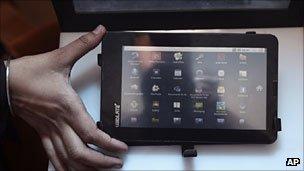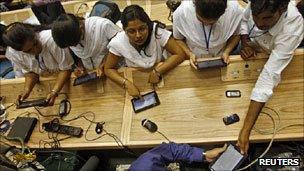Does India's budget tablet computer work?
- Published
India's recently launched Aakash is the world's cheapest touch-screen tablet computer - with an off-the-shelf price of about $60. Should we all run out to buy one?
In this tablet-crazy age, you'd think a $60 hand-held Android tablet might trigger midnight queues and riots. Or at least get tech columnists really excited.
But India's super cheap tablet was launched to a less-than-rousing reception, thanks to a history of false starts and hype.
When first announced, the Aakash prototype turned out to be not much more than an oversized memory box. Its ancestor, the functional hand-held Simputer, had flopped over and died.
This tablet started its life as Sakshat, with a $35 subsidised price tag for students. In its shipping form, it's called Aakash, and it will cost 2,999 rupees ($62).
I wasn't expecting much when I took it out of the box, but I was pleasantly surprised.

The Aakash is mainly aimed at students
This wasn't another shoddy prototype: it was a full production unit, packaged and shrink-wrapped and "properly" factory-made.
I liked the almost-pocketable size and weight, which reminded me of Samsung's 7" Galaxy Tab, a very capable and underrated Android tablet that died before its prime.
But there, the similarities with the Tab ended.
The Aakash wouldn't start until charged for about five minutes. We're rather used to out-of-the-box power on; this device does not appear to hold charge for long even when switched off (it should have been factory-charged, for testing).
Mixed feelings
My first action on screen, the Android "unlock" swipe, showed up the rough edges of the display technology.
To cut costs, the Aakash uses a resistive touch-screen, instead of the now common capacitive variety.
Resistive touch uses a pressure-sensitive overlay, and is better suited to a stylus than a bare finger. The Aakash's touch sensitivity and speed are lower than what we're used to with today's touch-screens. (Resistive touch can be very precise, but is rarely so in the cheaper varieties.)
It also uses lower specs than we're now used to with tablets and netbooks.
There's 256 MB of memory and 2GB of storage (tablets start at 512MB and 16GB today), and a slow 366 MHz processor (a third of the 1GHz norm).
There's built-in wi-fi in this basic Aakash tablet. Another version, which I could not get hold of, has GPRS data connectivity, with 3G planned later.
What they've added on beyond the average tablet is two USB sockets.
I have mixed feelings about this probably-unique feature in the tablet world.
USB lets you use cheap "memory sticks", but having that stick jutting out of the top of a small tablet can make it unwieldy. And two of these slots?
The micro-SD card slot is a good thing, and I miss that in my iPad (Apple doesn't believe in expandability).
So what about the "made in India" part?
The Aakash Ubislate is assembled in DataWind's Hyderabad factory. The plant has a capacity of about 2,000 units a month, to be "eventually" ramped up to 100,000 a month.
As you'd expect in this global age, parts are sourced from all over the world. To try to "make" everything in any one country, whether India or the US, would be stupid. About a 10th of the components, by value, are locally sourced.
And the overall design (including adding USB!), the integration and the testing are probably all Indian. None of this is trivial.

Cheapest... but the Aakash has limitations
If you're an Android user, the big thing you'll miss on the Aakash is the Android Market.
That's where you'd usually go to for downloading or buying apps, as with Apple's App Store. Instead, there is GetJar, a relatively limited service mostly selling apps for phones.
The tablet's low-end specs are probably a good reason to limit functionality and apps. But removing Android Market does mean no access to the hundreds of thousands of Android tablet apps out there.
The other reason could be application focus: so that students using the Aakash stay with a limited set of apps, both to avoid distraction, and to avoid slowing things down to unusable levels.
All this would be less relevant if there were great educational content ready. There isn't.
Yes, delivering a tablet for $60 has taken hard work, extraordinary sourcing and some innovation.
But this is just a part of the uphill road to a successful device that could change education in India. There are many more pieces needed to complete that picture.
As the Simputer in India and so many iPad-wannabe tablets in the world have shown, it isn't about the hardware.
Great hardware is a sine qua non, but what you really need are the apps and content ecosystem.
While the courseware development happens, the world will move on, with even better tablets that leave the Aakash further behind.

The low battery life of the tablet is a concern
And while I like the 7" size for its portability, students will find it less friendly than a 10" display for educational apps. But yes, that would cost more.
And the battery is rated for three hours; we got a bit over two. The Aakash warms up in use. That means precious battery power is going away as heat.
So every school kid who uses it will probably need a charging socket in their desk. And that's not likely to happen soon. Leaving it to charge repeatedly in common areas is not practical, for a variety of reasons.
Cheaper plastics and a flimsy screen cover don't bode well for heavy student use. Nor for serviceability: after removing the inside screws, I couldn't put them back because the plastic threads had slipped.
Probably the biggest challenge for the Aakash will be to keep up with the times. That's what killed the Simputer - other than apps, by the time they tweak it and test it, portable computers will have jumped a generation.
Which is why it makes little sense to spend this much time and effort in "made in India" development.
So what other device could the Indian government have picked to subsidise? My bet would be either a cheap standard netbook, or an ultra-cheap, usable e-book reader that instantly access the vast amount of almost-ready content.
Prasanto K Roy (pkr@pkr.in, twitter: prasanto) is chief editor at CyberMedia, a leading technology publishing group in India.
- Published5 October 2011
- Published23 July 2010
- Published14 June 2010